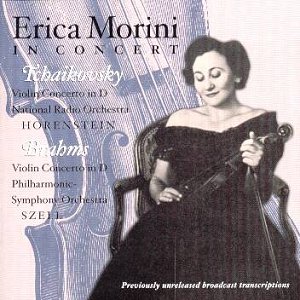Morini admirers are faced with a pleasurable choice.
They can choose the commercial recordings she made of the Tchaikovsky
and Brahms Concertos with the RPO and Rodzinski (now on Westminster
471 200) and can add as a provocative ancillary the live performances
of the same works contained in this Music and Arts CD, in both cases
with different conductors. The earlier, the Brahms, comes from a New
York broadcast in 1952 conducted by George Szell, long attributed I
believe to Bruno Walter, a well-known admirer of the Viennese violinist.
The Tchaikovsky, from five years later, was recorded in Paris with Jascha
Horenstein conducting the Radio Orchestra in Paris. Both performances
are instructive and we should be grateful that companies such as Music
and Arts and Arbiter are now supplementing Morini’s somewhat restricted
commercial discography with a number of live concerto performances from
the 1950s and 1960s.
Her Tchaikovsky is notable for a number of reasons.
Though she had a small tone with a limited vibrato – her training with
Sevcik was quite distinct from that of, say, her Russian contemporaries
– she was still able to compete in the romantic masterpieces. Others
before her who lacked opulent tonal projection but who possessed stylistic
affinity – Zimbalist for example – could equally carve out a niche for
themselves and so could Morini even if objectively her tonal armoury
was ill equipped for this kind of repertoire. But the clarity of her
bowing in the opening movement is without question and her technique
is strong and resilient (it was never a transcendent technique but it
was equipped to deal with pretty well all exigencies). Morini doesn’t
make a big sound nor is she tonally vibrant; she is at the furthermost
point from a tonalist such as Elman in this work, all molten ash and
succulent romanticism. Her lower strings can also be a little steely,
a problem that was to grow over the next decade. The recording has her
quite forward in the balance so some orchestral detail is rather submerged
(wind counterpoint for example) but equally it catches her passagework
with clarity and it shows her to advantage. Her Andante is quite without
the emotive finger position changes of Elman, or the razor intensities
of Heifetz. But her trill is good, if not of electric velocity and her
stylistic identification is on a superior plane. The woodwind principals
are thankfully far more audible here and in front of them Morini phrases
with what one could best call sweet gravity. There are some expected
cuts in the finale. Here she phrases without vibrancy but not without
affection. There is no great tonal allure here but equally an absence
of glamorous pose and she pays attention to the orchestral architecture;
the passage with the double basses is an example (there are many) of
her intelligent projection of a musical line, abetted in this respect
by Horenstein. In addition to the commercial Rodzinski and now this
performance Morini made a set of 78s of the concerto with Defauw and
an even earlier performance apparently exists, from 1940, with the New
York Philharmonic-Symphony conducted by none other than Stravinsky.
Whilst my own inclinations are for the romanticised opulence of an Elman
I admire Morini’s Tchaikovsky; she meets it on her own terms and that
is admirable.
Music and Arts are very straightforward about the various
aural problems on these transfers (Tchaikovsky minor if with an upfront
violin perspective, Brahms rather more problematical) so it’s as easy
for me to quote them with regard to the Brahms; "gravel, ticks,
surface noise, peak distortion, intonation problems, bad interpolations
or dropouts, glips, bad change of disk." I’m not so sure what a
glip is – but I can guess – but this litany of imperfections will doubtless
have you shaking in your headphones. No need, really; the sound is far
from perfect but not at all the blizzard of inaudibility you might have
expected. Right from the start Szell leads a commanding performance,
Morini entering with a fast trill, quick slide and very restrained vibrato.
She is far more intent on the delineation of the line and unaffected
stylisation than in artificial projection. Her technique is robust,
allowing a pretty brisk basic tempo without an undue feeling of haste
and even when she might reasonably dig into the string she doesn’t –
her preference is for establishing her own temperamental proprieties
in the work, aligning vibrato usage with her own expressive potential
and stylistic norms. Her instincts keep her moving toward the structural
climaxes rather than dallying for moments of incidental emotive intensity.
The tuttis are really trenchant in Szell’s hands.
Her tone in the slow movement is again crystalline
without any hint of opulence; intonation is good, her technique holding
up well in a work in which others can tire alarmingly. Again those sometimes
problematic lower two strings remain well equalized allowing her a degree
of lyric purity with which to inflect the line; the slow movement is
supple and refined. Szell animates the finale with very strong accents
and almost baleful tuttis (some slight overloading here, perhaps inevitably).
The brass is powerful and Morini fine if without the gypsy eloquence
to drive the music yet further forward. If the stronger impression is
made by Szell, Morini is true to herself and plays with an unaffected
sense of direction and luminosity.
I tend to favour Morini in the classical repertoire.
In romantic music her training had not equipped her, as it had others
of her generation, for the tonal and expressive potential of sophisticated
vibrato usage, amongst other devices. Nevertheless this disc shows,
not least in a live performance, how she could bring something of her
own to this repertoire and how an immaculate stylist could reward listeners
with her own brand of chaste romanticism. A revealing disc then and
no complaints from me about the sound or Allan Evans’ documentation.
Jonathan Woolf
